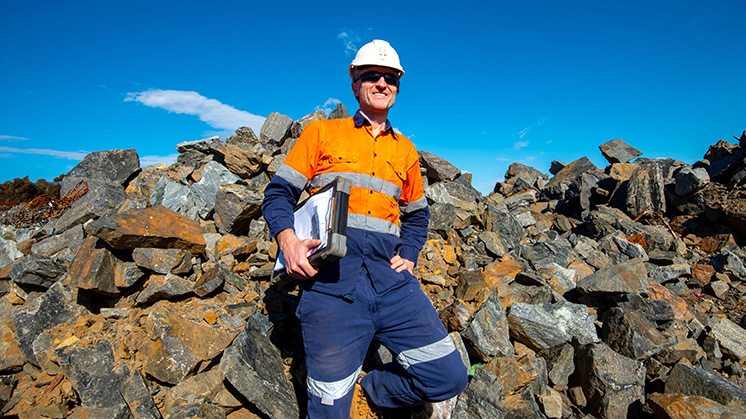
After a multi-year bank rally, many Australians are over-exposed to financials. That’s not where you want to be when the cycle turns, argues Perpetual’s Sean Roger
- Resources taking market leadership from banks
- Copper, iron leading
- Find out about Perpetual Equity Investment Company (ASX:PIC)
- Browse all Perpetual’s Australian share funds
Australia’s big miners are starting to capitalise on surging copper and resilient iron ore prices – a shift that looks set to finally move ASX leadership away from the banks, says Perpetual portfolio manager Sean Roger.
Leadership on the ASX has long swung between financials and resources, with whichever sector leads typically determining overall index returns.
After two strong years dominated by major bank stocks, momentum now appears to be tilting back towards miners as supply constraints meet firm demand for key commodities.
That rotation risks leaving many investors positioned the wrong way – overweight banks and underweight miners, says Roger, who co-manages Perpetual Equity Investment Company (ASX:PIC), Perpetual SHARE-PLUS Long-Short Fund and Perpetual Pure Equity Alpha Fund.
“After two years of 30 per cent index returns from banks, the financials sector’s weight in the index – and therefore in many super portfolios – is at the upper end of historical ranges.
“And after two years of underwhelming resources returns, the weighting of mining stocks is well below the peaks of previous commodity upswings.
“If the cycle turns, that’s not where you want to be positioned.”
Copper supply shock
The earliest sign of a shift back to resource leadership was the sharp spike in copper prices after a fatal mudslide closed US miner Freeport-McMoRan’s Grasberg mine in Indonesia, says Roger.
Grasberg – in the highlands of New Guinea – is the world’s second-biggest copper mine and accounts for about 3 per cent of global output.
Copper is an essential part of modern infrastructure, from power grids to data centres, and is one of clearest beneficiaries of long-term stockmarket themes like the growth of AI and the transition to net zero.
Grasberg’s closure is just one of several setbacks for global producers.
Flooding in the Congo, outages in Chile and production cuts by Canadian miner Teck Resources are all compounding an already-tight supply picture.
“These outages have created a range a of supply-side challenges just as demand from electrification and data-centre construction is accelerating,” points out Roger.
BHP and Rio to benefit
The resulting supply squeeze sets up the earnings outlook for ASX major’s BHP Group and Rio Tinto, Roger says.
“BHP and Rio have got decent copper exposures.
“BHP has over 40 per cent of its earnings exposed to copper. Rio is in the mid-20s – and that’s before the price rise.
“So for the first time in a while, we’re back in an environment where the current earnings for these businesses is much higher than where the consensus is.
“That means we’re in earnings-upgrade territory, and they’re pretty cheap; whereas the banks have still got muted earnings outlooks and they’re expensive.”
When commodity prices are high, big resources businesses like BHP and Rio tend to generate high, free cash flow which ultimately means investors should be rewarded with higher dividends.
“That means we should see the share prices continue to be supported,” says Roger.
Iron ore surprisingly resilient
The two majors are also benefitting from stronger-than-expected iron pre-prices, which remain around US$105 a tonne compared with long-term consensus forecasts closer to US$85.
“The strength of the iron ore price has surprised the market,” says Roger.
“Iron ore continues to trade well above where people think the long-term price should sit.”
China remains the key driver of iron demand but shifts in the Chinese economy means it’s no longer simply a property construction story.
“Historically all the focus has been on iron ore’s exposure to the Chinese property market – but that’s changing over time,” says Roger.
“In 2010, building and construction was 42 per cent of total Chinese steel demand in 2023 – but in 2023, that had fallen to 24 per cent.
“It’s a more diversified end market – and Chinese property has become materially less influential. Spending on infrastructure, exported goods and large capital projects is showing resilience.”
Resources drive ASX
The materials sector accounts for some 20 per cent of the S&P/ASX 200 index, meaning commodity prices are a powerful influence on overall market returns.
“Because resources are a very cyclical industry, the relationship between banks and resources stocks is cyclical.
“You often find that when one is in favour, the other is out of favour – and they tend to be funding agents for each other.
“This is a fundamental problem with index-investing for cyclical sectors – market leadership keeps shifting.
“When banks outperform, the index automatically allocates more to them – and less to resources.
“But is this really the right time to have historically high exposure to banks and historically low exposure to resources?”
Well positioned for a shift
Roger has been positioning Perpetual Equity Investment Company (ASX:PIC) for the shift.
“We have been underweight banks, which has been a painful trade.
“We made a call about three or four months ago to completely sell out of the banks because we saw better uses for that capital elsewhere.
“We now don’t own any banks, and we’ve got an overweight position in resources.”
About Sean Roger and Perpetual equities
Sean is deputy portfolio manager for Perpetual’s SHARE-PLUS Long-Short Fund and Perpetual Pure Equity Alpha Fund.
Perpetual is a pioneer in Australian quality and value investing, with a heritage dating back to 1886.
We have a track record of contributing value through “active ownership” and deep research.
Browse Perpetual’s Australian equities capabilities
Want to know more? Contact a Perpetual account manager

